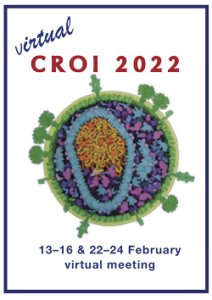CROI 2022: Dual bNAb treatment maintains undetectable viral load off-ART in 44% of children in the Tatelo Study
1 March 2022. Related: Conference reports, Paediatric care, Cure-related research, CROI 29 (Retrovirus) 2022.
 Polly Clayden, HIV i-Base
Polly Clayden, HIV i-Base
Data from a proof-of-concept study, conducted in Botswana and presented at virtual CROI 2022, showed treatment with broadly neutralising antibodies (bNAbs) maintained viral suppression for 24 weeks without ART in early-treated children with HIV.
Tatelo Study evaluated monthly combination intravenous VRC01LS and 10-1074 as an alternative to ART in a cohort of very early treated children.
Children were recruited from the Early Infant Treatment (EIT) cohort, who had received continuous ART, starting at 7 days old or less (and 1 child with intra-partum infection started at 31 days). Eligible children were at least 96 weeks old and had viral load <40 copies/mL for 24 weeks before entry.
Following 8 weeks of overlap with ART (the first 6 participants had 32 weeks while awaiting PK assessment of dual bNAb dosing), ART was stopped and bNAb treatment was continued.
Intravenous infusion doses were: VRC01LS 30 mg IV load, 15 mk/kg IV every 4 weeks; 10-1074 30 mg/kg IV every 4 weeks.
Viral load was tested every 1–2 weeks and ART was restarted (and bNAbs discontinued) if >400 copies/mL, or at 24 weeks. Viral load was checked weekly until <40 copies/mL after re-starting ART.
Twenty-eight children entered Tatelo Study. Median age was 3.6 years (range: 2.4 to 5.6) and median CD4 count 1198 cells/mm3. All were receiving lopinavir/ritonavir-based ART.
Three had viral rebound (all in 8 week overlap group). In two participants this was before starting bNAbs and one child rebounded at 4 weeks of ART + bNAbs.
Twenty-five continued bNAbs alone. Of these 11 (44%) maintained viral load <40 copies/mL through 24 weeks. These children were categorised as successes with 95% CI 24 to 65%. One participant had a single viral load result of 234 copies/mL at week 16 but re-suppressed to <40 copies/mL.
Fourteen (56%) had viral rebound to >400 copies/mL during 24 weeks of bNAb only treatment. Median time to failure for these participants was 4 weeks (range 1 to 20).
These results exceeded the study’s pre-defined threshold for success of 30%.
When the investigators looked at characteristics of children categorised as successes, those with longer ART + bNAb overlap were more likely to succeed: 5 of 6 (83%) with 32 week overlap. Children enrolled earlier in the study were also more likely to succeed (those with longest continuous viral suppression were enrolled first). As well as those with favourable clinical and reservoir characteristics.
By response group, sustained viral suppression on ART before receiving bNAbs, which occurred in 9 of 11 successes (82%) vs 4 of 14 (29%) failures; and median DNA from PBMCs at birth, 155 copies/106 successes vs 784 copies/106 were significant predictors of success (both p>0.02).
For the 14 children who failed on bNAbs alone, ART was re-started at a median of 4 days from rebound. Median viral load on the day of re-start was 4.42 log10 copies/mL. Re-suppression to <40 copies/mL was achieved in all children, at a median of 4.1 weeks (range 1 to 20) from ART re-start.
The investigators noted that no child in either group had a concerning pattern of CD4 decline.
No infusion reactions were reported and bNAbs were well-tolerated with only 5 grade 3 events – 1 neutropenia was judged possibly related to study drugs. There were no grade 4 events.
bNAb concentrations were considred adequate. During the bNAb only period, overall mean pre-dose troughs were in the expected range: VRC01LS, 281 mcg/mL and 10-1074, 256 mcg/mL.
Ongoing analyses include: PBMC HIV DNA change over time, baseline viral sequencing to look for pre-existing resistance and neutralisation assay data for bNAbs at failure.
comments
In this impressive proof-of-concept study, dual bNAb treatment with VRC01LS and 10-1074 maintained viral suppression for 24 weeks in the absence of ART.
Presenting author Roger Shapiro added: “Newer bNAb combinations with greater breadth and potency, used in children with favorable pre-treatment characteristics and possibly with longer bNAb/ART overlap, may improve treatment success for this novel ART-sparing strategy.”
For example, long-acting LS formulations, including 10-1074-LS, enable 3 to 6-monthly dosing that would making this a much easier intervention.
Reference
Shapiro RL et al. Treatment with broadly neutralizing antibodies in children with HIV in Botswana. CROI 2022. 12–16 February. Virtual. Oral abstract 32.
https://www.croiconference.org/abstract/treatment-with-broadly-neutralizing-antibodies-in-children-with-hiv-in-botswana/
This report was first published on 17 February 2022.

